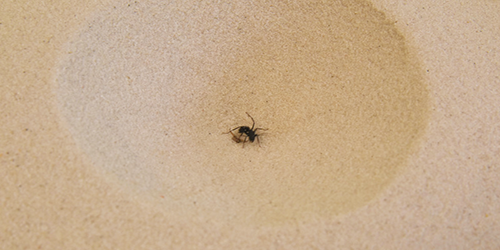A Broader Stance Can Stop a Sandy Slide
The mite-like larvae of insects called antlions dig sandpits and wait at the bottom with open jaws for passing ants to lose their footing, fall in, and become dinner. Inspired by that biological example, Miguel Piñeirua and his colleagues at the University of Tours, France, have investigated what determines the stability of multilegged locomotion on a granular slope [1]. Their experiment and model demonstrate that pressure exerted by leg contacts is crucial to forestalling instability, but so too is the distance between the contacts. The finding could inform robotic designs.
A previous study showed that sliding down an inclined, granular slope starts when an object’s weight slightly deforms the surface and stops when the object is heavy enough to plow up a blockading ridge of grains (see Synopsis: Friction Means Life or Death for Ants). These studies examined single sliders—metal disks dropped onto a hillside of millimeter-diameter glass beads. Piñeirua and his colleagues instead created four-legged sliders from plexiglass disks fixed together.
The researchers placed sliders of different weights and disk separations onto glass bead hillsides, slanted to an angle just below the one at which avalanches occur. For sliders heavy enough to disturb the grains, those with smaller disk separation behaved like a single disk and plowed up a collective ridge. Those with more space between disks generated four individual ridges, slowing their fall more immediately. The sliders most quickly reached stability when the distance between disks was maximized at 2.5 times the disk diameter.
The team built a model that estimated a stability criterion and suggested that the relationship between a multilegged creature’s mass and leg-separation distance determines whether it slips down a sandy slope or stays put. This could be useful information for robots that explore Mars or rescue hikers.
–Rachel Berkowitz
Rachel Berkowitz is a Corresponding Editor for Physics Magazine based in Vancouver, Canada.
References
- M. Piñeirua et al., “Substrate-mediated leg interactions play a key role in insect stability on granular slopes,” Phys. Rev. E 108, 014903 (2023).




